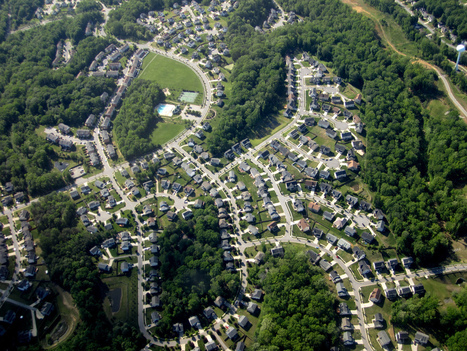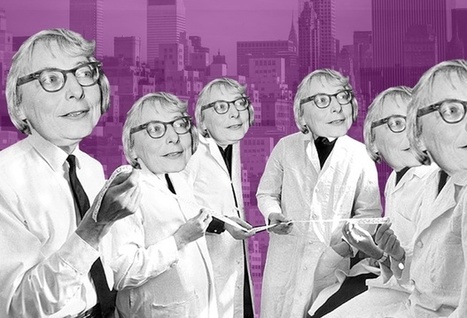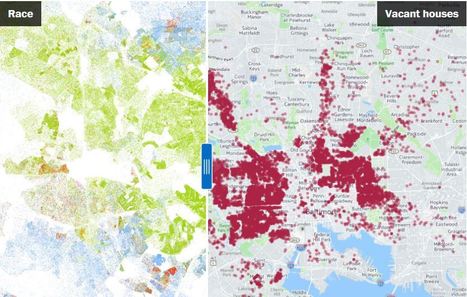 Your new post is loading...
 Your new post is loading...
"Although we seldom think about them this way, most American communities as they exist today were built for the spry and mobile. We've constructed millions of multi-story, single-family homes where the master bedroom is on the second floor, where the lawn outside requires weekly upkeep, where the mailbox is a stroll away. We've designed neighborhoods where everyday errands require a driver's license. We've planned whole cities where, if you don't have a car, it's not particularly easy to walk anywhere — especially not if you move gingerly. This reality has been a fine one for a younger country. Those multi-story, single-family homes with broad lawns were great for Baby Boomers when they had young families. And car-dependent suburbs have been fine for residents with the means and mobility to drive everywhere. But as the Baby Boomers whose preferences drove a lot of these trends continue to age, it's becoming increasingly clear that the housing and communities we've built won't work very well for the old."
Via Lindley Amarantos
Across much of the developed world, researchers have found that more young adults are living at their parents' home for longer periods of time. Across the European Union’s 28 member nations, nearly half (48.1%) of 18- to 34-year-olds were living with their parents in 2014, according to the EU statistical agency Eurostat. The Scandinavian countries have the lowest rates, with Denmark coming in at 18.6%. Southern and eastern European countries tend to have higher rates, led by the former Yugoslav republic of Macedonia: 72.5% of 18- to 34-year-olds reportedly were living with their parents.
"In just a few generations, we have tightly restricted American kids' freedom to roam, play, and become self-sufficient. The percentage of children walking and bicycling to school has plummeted from almost 50 percent in 1969 to about 13 percent today. Although distance from school is often cited as the main barrier to walking and bicycling, many families still drive when schools are close to home. According to the Safe Routes to School National Partnership, driving accounts for about half of school trips between 1/4- and 1/2-mile long — which in most cases shouldn't take kids much more than 10 minutes to walk."
ViaA rat, a Ouija board, mummified raspberries... what do you think is behind YOUR apartment walls?
"What, exactly, is a city? Technically, cities are legal designations that, under state laws, have specific public powers and functions. But many of the largest American cities — especially in the South and West — don’t feel like cities, at least not in the high-rise-and-subways, 'Sesame Street' sense. Large swaths of many big cities are residential neighborhoods of single-family homes, as car-dependent as any suburb. Cities like Austin and Fort Worth in Texas and Charlotte, North Carolina, are big and growing quickly, but largely suburban. According to Census Bureau data released Thursday, the population of the country’s biggest cities (the 34 with at least 500,000 residents) grew 0.99 percent in 2014 — versus 0.88 percent for all metropolitan areas and 0.75 percent for the U.S. overall. But city growth isn’t the same as urban growth. Three cities of the largest 10 are more suburban than urban, based on our analysis of how people describe the neighborhoods where they live."
Tags: urban, suburbs, housing, sprawl, planning, density.
Austin's Mueller neighborhood is a new-urbanist dream, designed to be convivial, walkable and energy-efficient. Every house has a porch or stoop, and all the cars are hidden away. After moving here, respondents said, they spend an average of 90 fewer minutes a week in the car, and most reported higher levels of physical activity. The poll results seem to validate new-urbanist gospel: good design, like sidewalks, street lighting, extensive trails and parkland, can improve social and physical health. Part II: A Texas Community Takes on Racial Tensions Once Hidden Under The Surface. Tags: housing, urban, planning, urbanism, unit 7 cities, neighborhood, podcast.
In the most innovative incubators of urban research, the lessons of Jane Jacobs are more vital than ever. In the past few years, a remarkable body of scientific research has begun to shed new light on the dynamic behavior of cities, carrying important implications for city-makers. Researchers at cutting-edge hubs of urban theory like the University College London and the Santa Fe Institute have been homing in on some key properties of urban systems—and contradicting much of today's orthodoxy. Their findings have begun to feed into recent and upcoming gatherings on the future of cities—including lead-in events for the U.N.'s big 2016 Habitat III conference on sustainable development—and arming leaders in the field with new ammunition in the global battle against sprawl.
Tags: density, urbanism, housing, urban, planning, unit 7 cities, labor.
Via Dawn Haas Tache
"Although we seldom think about them this way, most American communities as they exist today were built for the spry and mobile. We've constructed millions of multi-story, single-family homes where the master bedroom is on the second floor, where the lawn outside requires weekly upkeep, where the mailbox is a stroll away. We've designed neighborhoods where everyday errands require a driver's license. We've planned whole cities where, if you don't have a car, it's not particularly easy to walk anywhere — especially not if you move gingerly. This reality has been a fine one for a younger country. Those multi-story, single-family homes with broad lawns were great for Baby Boomers when they had young families. And car-dependent suburbs have been fine for residents with the means and mobility to drive everywhere. But as the Baby Boomers whose preferences drove a lot of these trends continue to age, it's becoming increasingly clear that the housing and communities we've built won't work very well for the old."
"Tracking changes in the shape of American cities over 10 years reveals which cities pack the most into a small space, but don't worry, sprawlers: Los Angeles shows you can change your fate."
Today’s nearly 314 million U.S. residents will expand to 401 million in less than 40 years. Wherever you fall on the cultural spectrum between country and city mouse, the fact remains that we simply won’t be able to use up resources the way we do now in sprawling suburbs shaped by car culture.
Tags: density, sustainability, housing, urban, planning, unit 7 cities.
In Iwan Baan's TED Talk, he shows 154 images in rapid succession. Here, he lets you spend more time with them, and appreciate the detail.
|
Austin's Mueller neighborhood is a new-urbanist dream, designed to be convivial, walkable and energy-efficient. Every house has a porch or stoop, and all the cars are hidden away.
After moving here, respondents said, they spend an average of 90 fewer minutes a week in the car, and most reported higher levels of physical activity. The poll results seem to validate new-urbanist gospel: good design, like sidewalks, street lighting, extensive trails and parkland, can improve social and physical health. Part II: A Texas Community Takes on Racial Tensions Once Hidden Under The Surface.
Tags: housing, urban, planning, urbanism, unit 7 cities, neighborhood, podcast.
Via Lindley Amarantos
"When others get off the train to finally go home, Leonie Müller stays behind. That's because she already is home: The train is her apartment, and she says she likes it that way. She bought a subscription that allows her to board every train in the country free. Now, Müller washes her hair in the train bathroom and writes her college papers while traveling at a speed of up to 190 mph. She says that she enjoys the liberty she has experienced since she gave up her apartment."
Tags: mobility, transportation, housing, popular culture, Europe, Germany.
WESTERN -- Michael Witt and his buddies set out from Johnson County in February 1861 and walked west, looking for land and a better life for their families.
From painted caves to 3-D printed houses.
How vacant houses trace the boundaries of Baltimore's black neighborhoods.
The map on the left shows one very tiny dot for each person living in Baltimore. White people are blue dots, blacks are green, Asians are red and Hispanics yellow.The map on the right shows the locations of Baltimore City's 15,928 vacant buildings. Slide between the two maps and you'll immediately notice that the wedge of white Baltimore, jutting down from the Northwest to the city center, is largely free of vacant buildings. But in the black neighborhoods on either side, empty buildings are endemic.
Tags: neighborhood, gentrification, urban, place, economic, race, poverty, spatial, housing.
How the narrative of documentary films portraying urban failure changed since the 1930s and shaped architectural and urban thinking.
"How much does size really matter? Judging by this tiny home in France, not a whole lot -- as long as the space is functional. On the seventh floor of an apartment building in Paris, there's an 86-square-foot apartment complete with a bed, kitchen, bathroom, table and chairs, closet, bathroom and storage space." --HPost
Two maps and six charts take sprawl rankings to another level.
International studio Urban Think Tank are currently exhibiting the ‘empower shack‘ in zurich. The project is developed as an adapting response to urban informality, offering not only improved housing but a strategy that allows the citizens of self-built urban communities to dynamically structure their urban environment as an instant response to their needs. An economical protoype two story metal-clad modular structure can be self-built. Each home is allotted a determined amount of space that allows the structure to expand as the inhabitants need it, still fitting within a more organized framework. Transsolar has also made it possible to incorporate solar energy on every rooftop. The ongoing project is intended to alleviate the housing crisis in informal settlements during a time when the government has begun incrementally improving the housing situation.
Via Lauren Moss
|



 Your new post is loading...
Your new post is loading...




































This is also an issue in Australia where the overwhelming majority of people live in single story dwellings and are very car reliant.
I can definitely see this as a real problem. Both my Uncle and my Great Uncle moved their condos from ones that had numerous steps to climb to the second floor to more elder-friendly options. My Great Uncle even went a step further to move him and his wife to a senior living community, where there food, entertainment, etc. is all provided within an enclosed neighbourhood with other people of their age group. More of these communities that act like oversized retirement homes could be the answer. They give the illusion of suburban living, something the baby boomers liked, while providing the accessibility they need.
APHG- HW Option 1